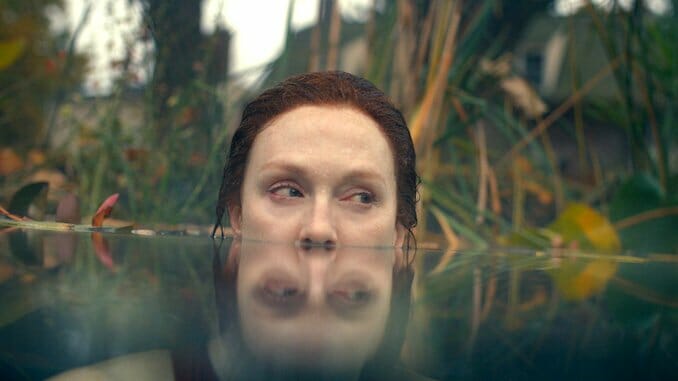No, Really. What Is Lisey’s Story in Apple TV+’s Lisey’s Story?
Photo Courtesy of Apple TV+
Stephen King has long maintained that Lisey’s Story, his 2006 horror-romance novel about the grieving widow of a best-selling writer, is his favorite in his extensive oeuvre. Talking to journalists in February during an all-virtual Television Critics Association press day to promote Apple TV+’s adaptation of Lisey’s, he justified his partiality by saying it’s “a story about love and marriage and the creative impulse. And it’s also got a kick-ass villain in it, which I liked a lot.”
Inspired by his wife, the writer and literacy activist Tabitha King, and her decision to clean out his office while he was recovering from a near-fatal battle with double pneumonia—and King’s own realization that these empty walls and boxes of materials would be exactly what the room looked like after he did pass away—Lisey’s Story the book, as well as the eight-part miniseries for which he created and wrote every episode, is really two stories in one.
It’s a story about an obsessive fan, a woman-hating (presumable) incel known as Jim Dooley, played by Dane DeHaan. He is convinced that his favorite writer, the late Scott Landon (Clive Owen), had unpublished works that need to be released posthumously for the betterment of the world. He offers to align with a professor (Ron Cephas Jones), who has a more level-headed view of the same cause and previously tried pressuring Scott’s widow Lisey (Julianne Moore) to release the goods. Jim’s methods come with verbal and physical threats and require Lisey to get creative. The character could be a metaphor for who “owns” the rights to a famous person’s work or image—the family or the world—but also asks the more obvious question of why Lisey doesn’t have any kind of security system at her house.
It’s also a story about grief; Lisey has spent the years since Landon’s passing more or less alone in their Maine farmhouse, while also managing her mentally ill sister Amanda (Joan Allen), and trying not to throttle her brash and opinionated other sister Darla (Jennifer Jason Leigh). Between all of this, she tries to get up the energy to sort through Scott’s belongings, reflecting upon their life together while remembering difficult parts of Scott’s past. These include his wretched childhood living under the rule of his abusive father (Michael Pitt), and his ability to teleport to another plane called Booya Moon thanks to a lot of running water. In Booya Moon, a healing pool can make you spiritually and figuratively well, but a disturbing monster made of human flesh called a Long Boy can hunt you down and destroy you (maybe now’s a good time to mention that J. J. Abrams, and his Bad Robot Productions, is an executive producer on the miniseries).
As if he were able to see the future when he was alive, Scott has left Lisey some scavenger hunt-like clues called “bools” to give her find ways to help Amanda when her sister becomes catatonic. But, as Lisey points out to Darla when she tells her about the notes, “grief is a bool hunt. My prize is learning how to be alone.”
But what is frustrating is that Lisey’s Story is not is a story of Lisey herself, in so much as she lacks any identity that isn’t linked to Scott. She has no career and no real ties to the outside world. Jim calls her “Yoko,” and she’s repeatedly admonished for “only” being a restaurant hostess when she and Scott got together as if she’s nothing but a gold-digger (never mind that he was a struggling author at the time or that any of these things aren’t just extremely sexist). Aside from her affinity for red tops and loose-fitting pants and her love-hate-love relationship with her sisters, it’s really hard to know anything about Lisey. Why was she a hostess? Did she want a career of her own? Did she want kids? Pets? Any sort of recognition for her own accomplishments? Why was she even called Lisey instead of her given name, Lisa? Why did Scott call her Babyluv? (Their wedding song was “Too Late to Turn Back Now” by Cornelius Brothers & Sister Rose, so don’t bring up The Supremes). Even though there is an actual Lisey’s Story in Lisey’s Story, it’s a story for Lisey from Scott; not one of her or by her.
This ends up making the miniseries rather predictable and slow even if the acting is great. It would be easy for Moore to drag viewers down with sorrow in this part, but she handles it the way a lot of people in mourning do. After the initial shock of your loved one’s loss, there are still bills to be paid, clothes to clean, sick relatives to attend to, estates to settle and, somewhere in there, simply an adjustment to the new normal. Who among us has not wanted to bang our head against a car window to allow us a moment of physical pain to deflect from the anxiety and emotional one?
-

-

-

-

- Curated Home Page Articles By Test Admin October 21, 2025 | 3:10pm
-

- Curated Home Page Articles By Test Admin October 21, 2025 | 2:57pm
- Urls By Test Admin October 21, 2025 | 2:57pm
- Curated Home Page Articles By Test Admin October 21, 2025 | 2:55pm
-

-

-

-

-

-

-

-

-

-

-

-

-

-

-

-

-

-

-

-

-

-

-

-

-

-

-

-

-

-

-




































